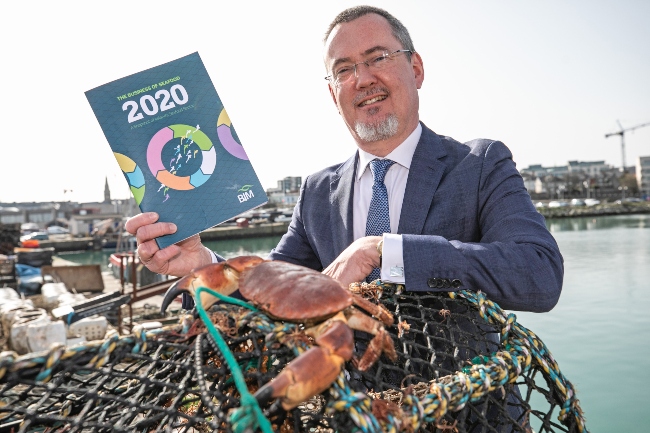Ireland’s seafood industry remains resilient and has adapted to significant market disruption, says Bank of Ireland’s head of Food Sector Roisin O’Shea.
The recent Bord Iascaigh Mhara (BIM) Annual Business of Seafood report indicates just how the sector overcame the challenges of both the pandemic and Brexit.
The total value of Ireland’s seafood economy in 2020 was just under €1.1bn. As with many other industries and sectors the pandemic has had an impact, and when compared year on year it represents a decrease of 12pc (-€142m).
“2020 was a challenging year for the Irish seafood industry, as it was one of the more exposed sectors to the decline in foodservice, however the prospects for 2021 are positive”
This was driven mainly by the severe disruption in global markets. In addition, the continued uncertainty of the UK’s departure from the EU made for challenging trading conditions.
Seafood sector ready to grow

BIM CEO Jim O’Toole. Image: Julian Behal
These factors, as well as the effective closure of the foodservice sector for much of 2020, saw a reduction of 18pc in domestic consumption. While exports to key markets in Europe and Asia fell, opportunities in other global markets emerged as the value of exports to Africa growing by 87pc and by 43pc to the Middle East driven by increased exports of mackerel.
Despite the pandemic, and even with reduced demand in the foodservice sector, employment in the seafood sector remained stable in 2020, and there continued to be more than 16,000 people employed directly and indirectly in the seafood industry. Employment remains high in coastal regions, generating significant socioeconomic value in these areas (16pc in Donegal, 7pc in Cork, 6pc in Galway-Clare and 6pc along the coastal region of the east coast).
The estimated value of the seafood industry in 2020 was €1.1bn, down 18pc, mainly due to a fall in sales in foodservice, however this was somewhat offset by a 6pc increase (€18m) in retail sales.
Fisherman’s blues
Domestic consumption amounted to €406m, down 18pc, exports-imports were valued at €263m, down 10pc and private investment was valued at €213, down 17pc reflecting the uncertainty in the markets leading to cautious activity from many seafood businesses. However, there was an increase of 9pc on government investment – an increase to €203m.
In 2020 BIM saw a value of €346m landed by Irish vessels into its ports. The biggest fishing ports are Killbegs at €112m and Castletownbere at €104m.
Domestic sales values stand at €316m for retail and €90m for foodservice.
The top-selling species are salmon (€120m) and cod (€46m).
Irish seafood exports in 2020 were down 8pc to €590m of which €321m was shipped to the EU while €93m worth of seafood went to the UK. In turn Ireland imported €188m worth of seafood from the UK.
The volume of seafood produced by the Irish seafood sector surpassed 220,000 tonnes with a value of €394m. While less than 20pc of this volume was produced by the aquaculture sector it contributed 46pc of the total value.
BIM CEO Jim O’Toole said 2020 was a difficult year for the seafood industry with many markets experiencing reduced demad, directly related to the Covid-19 pandemic.
“The Irish seafood sector sells a lot of its produce to foodservice markets in Europe and in Asia which experienced lengthy lockdowns significantly impacting sales,” said O’Toole.
“The industry showed great agility during the year and looked to alternatives for its products, switching where possible from supplying hospitality to supplying the retail market and online sales. Looking ahead, there are many reasons to be hopeful and the sector is set to avail of the opportunities that will emerge as markets reopen and we can look forward to some recovery as 2021 progresses, notwithstanding the new challenges introduced by the Trade and Cooperation Agreement with the UK.”
Opportunities ahoy!

Roisin O’Shea, head of Food & Drink, Bank of Ireland
Roisin O’Shea, head of Food & Drink at Bank of Ireland said that despite the challenges of 2021 there are oceans of opportunity for the sector to draw upon.
“The report confirms that 2020 was a challenging year for the Irish seafood industry, as it was one of the more exposed sectors to the decline in foodservice, however the prospects for 2021 are positive,” O’Shea said.
“The accelerated vaccine rollout will result in the opening of foodservice at the end of quarter 2. While the pelagic sector, in particular, will be impacted by some quota loss as a result of the Trade and Cooperation agreement, on the whole, the certainty the agreement provides in terms of access to UK waters as a result is very beneficial.
“Brexit has meant that the British processing and aquaculture sectors face significant barriers on their export to Europe. There are now 26 steps between a British seafood exporter and their customer on the continent and this is particularly critical for short shelf life exports.
“British seafood exports to the EU were worth £1.3bn 2019 and this is a huge opportunity for the Irish industry,” O’Shea said.
By John Kennedy (john.kennedy3@boi.com)
Published: 9 April 2021






